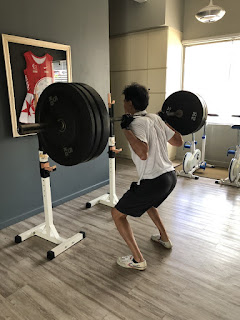For almost as long as I have been working as a physiotherapist (> 20 years), I have often heard other physiotherapists, trainers, strength and conditioning coaches tell patients that it's wrong to let their knees come forward when performing a squat. That by doing so, they will damage their knees. In fact, I've had many arguments/ disagreements with my ex colleagues at Sport Singapore (formerly Singapore Sports Council) regarding this.
To which I say that it's one of the biggest training myths ever. Yes, that your knees should not travel forward past the toes during a squat is definitely a myth.
In a study by Fry et al (2003), the authors looked at how joint forces at the knees and hips changed when restricting forward knee movement during a squat. What the authors found was that squatting with restricted forward knee movement showed a 22% decrease in knee forces while increasing hip forces by 1070%!
 |
| Picture A- knee travels forward, B restricted knee movement |
Yes, I do agree it's true that it does stress your knees more when you allow your knees to come forward while squatting. However, this is well within the normal limits of what the knees can handle (Schoenfeld 2010).
You go to any Crossfit gym and/ or watch any Olympic weight lifters and you will see that in order to reach full depth in the squat, their knees will almost always have to go forward past the toes (see picture below). The Olympic weight lifters will often do that with very high loads too.
 |
| Picture from Irving Henson taken at The Pit |
Different types of squats will have different types of knee forward movement as well. Front squat, high bar back squat, low bar back squat and box squats just to name a few.
So now you know that there is no real need to restrict forward knee movement when you squat, especially if you want to load your quadriceps more. As long as you are not squatting excessively and with a super heavy load like the Olympic weight lifters.
References
Fry AC, Smith JC and Schilling BK (2003). Effect Of Knee Position On Hip And Knee Torques During The Barbell Squat. J Strength Cond Res. 17(4): 629-633.
Schoenfeld BJ (2010). Squatting Performance And Kinematics And Their Application To Exercise Performance. J Strength Cond Res. 24(12): 3497-3506. DOI: 10.1519/JSC.0b013e3181bac2d7.
Now surely the knees have to come forward .... picture from Catalyst Athletics






No comments:
Post a Comment